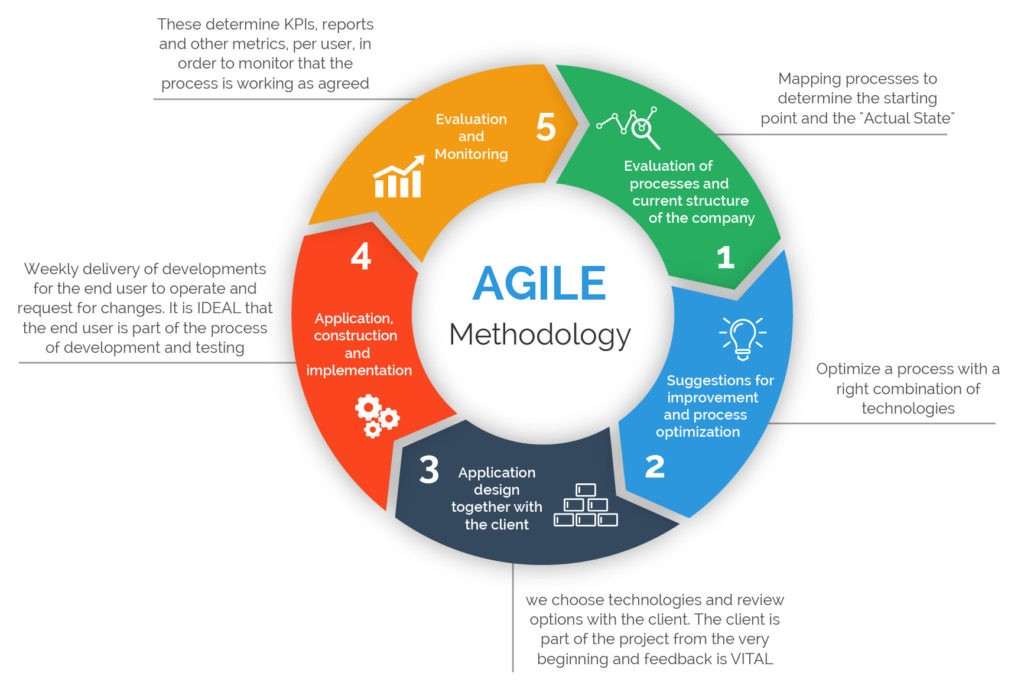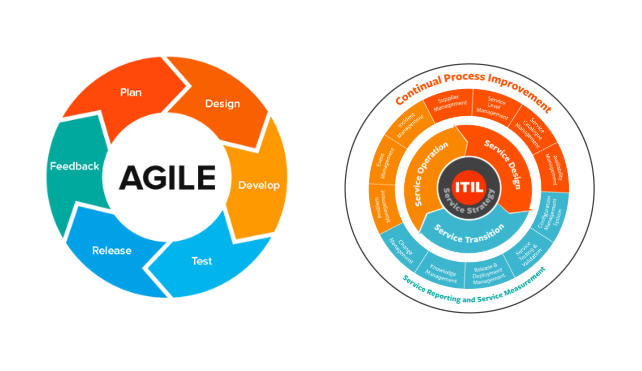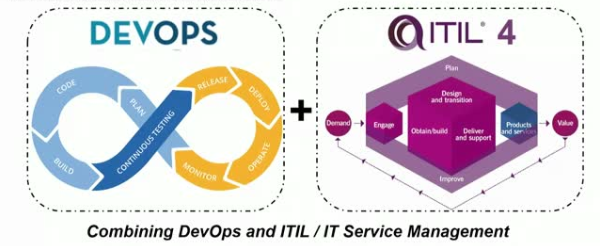ITIL vs Agile: Which Bootcamp Is Better for Your DevOps Career?
Successful organizations focus on optimizing and expanding their business processes, building quality end products, and fostering agility by leveraging various IT methodologies. Each of these frameworks, for example, ITIL (Information Technology Infrastructure Library), ITSM (IT Service Management), or Agile have their unique approaches on how to manage a project or execute it efficiently. ITIL and ITSM focus on optimizing the quality of the products or services delivered to the end customers. Agile, however, gives priority to fulfilling specific customer needs with the help of cross-functional software development teams.

Source: BMC
With DevOps, choosing ITIL vs Agile has become a favorite hot topic of argument because there is a lot of confusion on which one is the best framework for DevOps. The reason is both methodologies work on entirely different principles and values. However, with the transition from ITIL 3 to ITIL 4, things are changing as ITIL is gradually becoming more similar to Agile.
The seamless alliance of DevOps with ITIL and Agile principles has the potential to pave the way for quality service and the fastest product delivery in an Agile way. So, which is more relevant in the realm of DevOps, or do they work together for a more effective output?
ITIL vs Agile – The Key Differences
ITIL and Agile are two different IT methodologies that have gained popularity at separate times as tech engineers developed new technologies to replace the failed, old way of doing business. Before going into what they are and the key differences, you should understand the fundaments of these frameworks.
What Is ITIL?
ITIL (Information Technology Infrastructure Library) is one of the IT frameworks companies follow for maintaining their growth and progress. ITIL methodologies provide business processes and customer feedback details precisely to IT organizations for any product or services that facilitate the organization’s growth and any future upgrade plan. The goal primarily is to make its products or services better based on specific customer feedback.

Source: WikiMedia
What Is Agile?
One of the most commonly used IT frameworks, Agile helps in product development and satisfying sophisticated customer requirements with the help of cross-functional teams.
According to Agile, the key purpose of an IT organization should be quality optimization of multiple systems and faultless, functional product delivery, and customer feedback.

Source: Medium
The Agile framework follows common universal guidelines. Organizations use this methodology to deliver high-quality products when customers demand multiple functionalities and when multiple teams of developers work together to design, create, and develop the product or service.
ITIL vs Agile: The Key Differentiators
The key differences between the two IT methodologies Agile and ITIL are:
1. ITIL believes in codifying the mindset and business processes an IT organization should embrace for delivering uniform value. However, Agile aims at boldly innovating, shedding fear of “breaking rules,” and asking questions to deliver value quickly in an evolving IT environment.
2. ITIL is an IT framework entirety focused on processes rather than practices. However, Agile is a group of practices aimed at providing speedy software delivery.

3. ITIL gives priority to a strict methodology for fulfilling SLAs or explicitly worded service-level agreements. Agile, on the other hand, inspires IT organizations to enable smaller teams to operate enthusiastically and independently.
4. ITIL centers around helping IT organizations deal with IT service management for fostering client relationships, minimizing risks, and establishing economical business processes, and creating a stable IT environment that can embrace change and scale with time.
However, Agile is all about the quick deployment of software by optimizing the coordination between the development team and the end customers.
Keeping these differences in mind, ITIL and Agile look incompatible. Since the inception of ITIL 4, Agile and ITIL are becoming somewhat similar because ITIL 4 focuses on helping organizations work in sync with Agile and DevOps more efficiently.
Now that the basic differences are apparent, the next step is to explore how ITIL and Agile principles can integrate to deliver world-class IT products and services.
In a nutshell, ITIL includes nine guiding principles:
- Focus on the value delivered
- Design for user experience
- Start where you are
- Work holistically toward the product or service development
- Progress iteratively
- Observe directly
- Be transparent
- Collaborate with the stakeholders
- Keep it simple
The four key points of the Agile approach are:
- Individuals and interactions over processes and tools
- Working software over comprehensive development
- Customer collaboration over negotiations
- Responding to change frequently rather than following a plan
Can You Integrate Agile and ITIL?
Looking at the key differences between ITIL and Agile, the latter seems the opposite of the former. However, by leveraging the right techniques and a logical mindset, both IT frameworks can operate together efficiently in the IT service management economy.
ITIL gives significance to every aspect believed to be less important in the Agile mindset. On one hand, individuals and interactions have higher importance over processes and tools in the Agile economy. But on the other, ITIL concentrates primarily on procedures and systems to deliver quality end products and services.

Source: Medium
While it is well-known that Agile and ITIL software development aren’t the ideal matches, the adage “opposites attract” applies here. There are numerous ways in which these two methodologies can blend efficiently.
One of the striking similarities between Agile and ITIL is that both frameworks believe that “Working Software” is equivalent to “Focus on Value.” This means building the right products or services that the end customer can leverage. Both ITIL and Agile work on the “Keep It Simple” principle that emphasizes acting quickly and delivering the highest quality similar to “Responding to Change.”
Despite the differences, ITIL and Agile have strengths to overcome each other’s weaknesses and help IT organizations to come up with a blueprint for bringing maximum value to the stakeholders and customers.
A potential roadblock that might get in the way of seamless Agile and ITIL integration is that Agile is an iterative approach that focuses on developing and updating Minimum Viable Products (MVPs) in short timeframes. However, ITIL strictly follows a sequential framework. This might lead to some instability in the processes but with a cautious approach, it’s resolvable.
The key to remember is that Agile is successful in fast-paced IT environments, and this tactic ITIL can implement to support IT and service teams and to adopt changes as and when required.
The truth is, while these best practices represent a full DevOps framework, DevOps depends on collaborative and iterative processes. It supports the ideology of continuous development and deployment. Comparing DevOps to either Agile framework or ITIL software development practices brings up additional questions of what the Agile and ITIL goals are.
Think of it this way. Agile is a set of practices to have faster software delivery. ITIL is a framework focused on processes and not practices.
ITIL vs Agile: Which Bootcamp Is Better for Your Devops Career?
Agile and ITIL are not the best of buddies, but they are surely not foes. Both the frameworks can integrate for building a successful DevOps culture.
DevOps is the practice of filling the gaps between business operations and development processes with the help of seamless collaboration, communication, and shared goals.

Source: Medium
Unlike ITIL, DevOps doesn’t have a group of best practices for the development team. Also, the Agile approach is an iterative framework that focuses on content changes while DevOps concentrates on consistent testing and software delivery.
Despite these contrasting differences, ITIL and Agile can coexist pretty well in the DevOps economy because their ultimate objectives are quite similar. Users can leverage ITIL to ensure quality in IT products and services, and they can incorporate Agile principles to deliver a consistent stream of advancements in applications.
With the inception of ITIL 4, Agile and ITIL will become even more aligned to provide perks to DevOps.
The Dilemma of Establishing a Career to Devops Using Agile vs ITIL Ideology
The crucial lesson learned when analyzing ITIL and Agile is that both are extremely popular project management frameworks offering perks that IT teams should know and leverage according to the situation.
ITIL makes sure of the holistic growth of any IT company and offers future strategies for evolution. Agile guarantees seamless product delivery to the end customers, which, ultimately, lets ITIL capture the organization’s growth and future progress. ITIL and Agile both are complementary in DevOps because ITIL ensures value and quality and Agile fosters continuous improvement.
When all businesses across the world are in a state of constant flux, the technology landscape supports growth and scaling. IT teams are responsible for keeping pace with the latest technologies, innovations, and the corresponding customer demands. Along with that, they must keep up with newer ways of thinking and business solutions. As a result, in the present IT culture, choose a framework that fits the Agile purpose.
In case you are curious to explore more about ITIL, Agile, and DevOps check out GreyCampus, which is the leading provider of IT certifications. You can crack any Agile or ITIL interview to get lucrative jobs by choosing the best course that aligns with your interests.
Want To Kickstart Your Career in DevOps? Get ITIL Certified Today!
